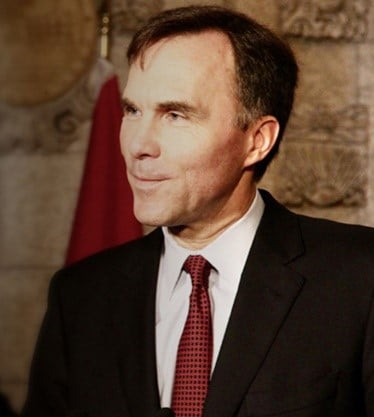New Down Payment Rules: Time to Exhale

Finance Minister, Bill Morneau
If you’re trying to scratch together a down payment, or you sell mortgages for a living, today’s news could have been much, much worse.
The new down payment rules Finance Minister Bill Morneau announced this morning were as benign a policy change as one could hope for. This refers, of course, to the new minimum down payment requirement, which takes effect on February 15, 2016.
For properties between $500,000 and $1 million, folks getting an insured mortgage will now need to put more down—up to an additional 2.5% of the purchase price. In other words, 5% down will be required on the first $500,000, and 10% down will be required on the next $500,000.
For a $750,000 property, that means you’d have to cough up a 33% bigger down payment (compared to today), or another $12,500. The new rule doesn’t affect properties over $1 million because they don’t qualify for high-ratio mortgage insurance anyway.
As we reported last week, it seemed clear that some sort of down payment changes were on the way. But the speculation was that Ottawa would impose a flat 7-10% down payment for properties between $500,000 and $1 million. The actual rule announced today will affect far fewer borrowers than that (Benjamin Tal estimates about 4% of buyers overall). Many folks buying in that price range will find a way to scrape up an extra $5,000 or $25,000—from mom and dad, from borrowing their down payment, from selling other assets, etc.
Of course, buyers without other resources may have to save for another one to three years to buy a higher-priced home. But the deferral of these buyers will barely put a dent in home prices, at least in cities where high-value properties and multiple offers are the norm. (Properties over $500,000 in smaller metros will be more impacted.)
The changes I’d be more concerned about, as a consumer, are the higher securitization fees and larger capital requirements for lenders. These policies were announced in tandem with the down payment tweak.
Most lenders will absolutely pass down some or all of these costs to consumers. In fact, with the rate increases of late, some speculate they already have been.
I’ve been researching all day on what that means for mortgage pricing. The potential impact looks to be in the range of 3-8 basis points for the securitization fee change (depending on the lender), and another few basis points for OSFI’s additional capital requirements. Let’s call it a total 5-10 basis-point hike in mortgage rates over time.
CMHC says “the changes in guarantee fees are not expected to have a material impact on the level of mortgage rates, which remain at historically low levels.” And it’s right. But 5-10 basis points means a well-qualified ultra-low-risk borrower will cough up another $700 to $1,400 in interest over five years on a 5-year $300,000 mortgage. And who wants to pay that?
Then again, there’s a case to be made for building the war chests of CMHC and lenders, in the highly unlikely event that home prices crash land. So at least borrowers can take solace that their hard-earned interest payments are going to a “good” cause.
*******
Implementation details:
- Qualified borrowers who get approved before February 15, 2016, can still buy with only 5% down. But lenders will likely set their application submission deadlines 1-2 weeks earlier.
- People will still pay the same default insurance premiums, based on their overall loan-to-value (e.g., 3.60% of principal for a 5% to 9.99% down payment).
- Check out these FAQs for more details.
On securitization:
- CMHC’s intent was to raise CMB costs equally on small and large lenders alike. The increased cost amounts to roughly 40 bps for all lenders, says a source very familiar with the change.
- The new guarantee fees reduce the attractiveness of securitizing via Canada Mortgage Bonds, relative to NHA MBS (where fees are also going up for lenders issuing over $7.5 billion worth of NHA MBS).
- The MBS guarantee limit was raised from $80 billion to $105 billion for 2016, but it won’t create any more MBS funding or risk. The extra is just to support new requirements of the CMB program.
- The government’s stated purpose of these fee hikes was to “encourage the development of private market funding alternatives by narrowing the funding cost difference between government-sponsored and private market funding sources.” Good luck with that. Insured mortgages, to which these fees apply, can’t be securitized outside of CMHC-sponsored channels. And no “private” CMHC-sponsored securitization markets exist (that we know of anyway).
Other effects:
- First-time buyers were mostly spared by these new down payment regs. Their average purchase price is $293,000, well under the $500,000 threshold.
- Moreover, less than 1 in 10 first timers are buying $500,000+ properties to begin with.
- Calgary could get hit the hardest (just what they need), because they have a much larger share of high-ratio mortgages, says Tal.
Comments:
Post Your Comment: